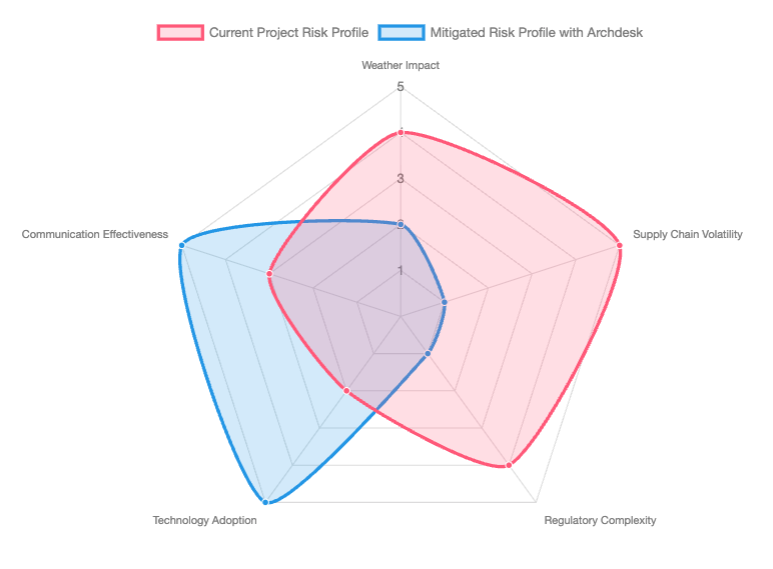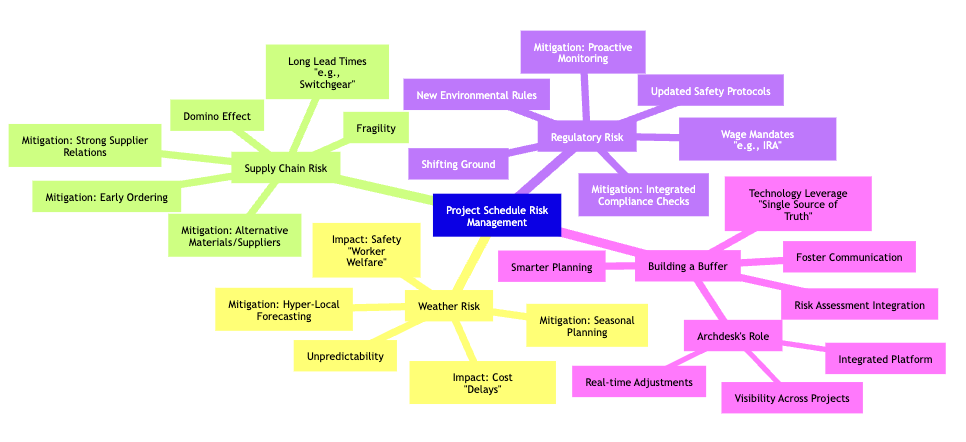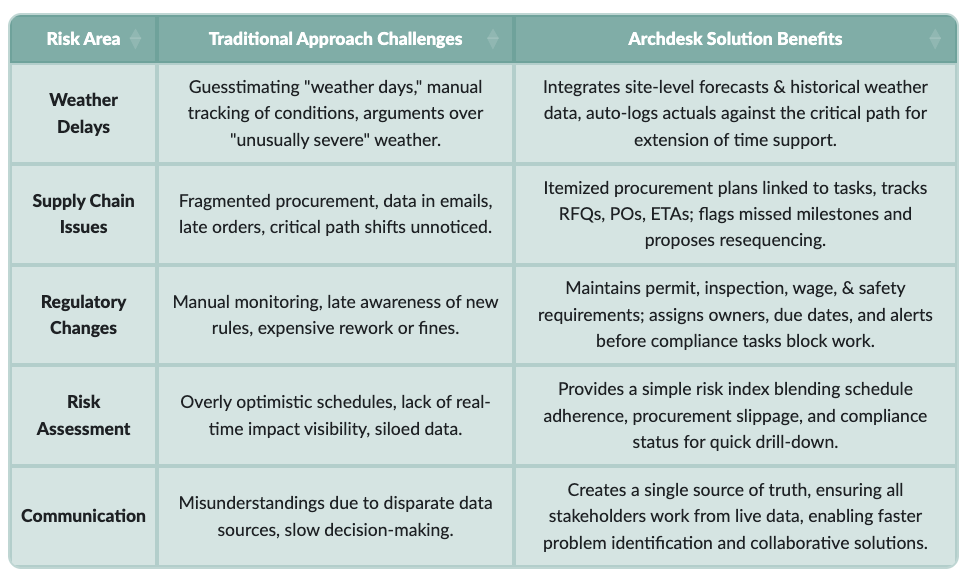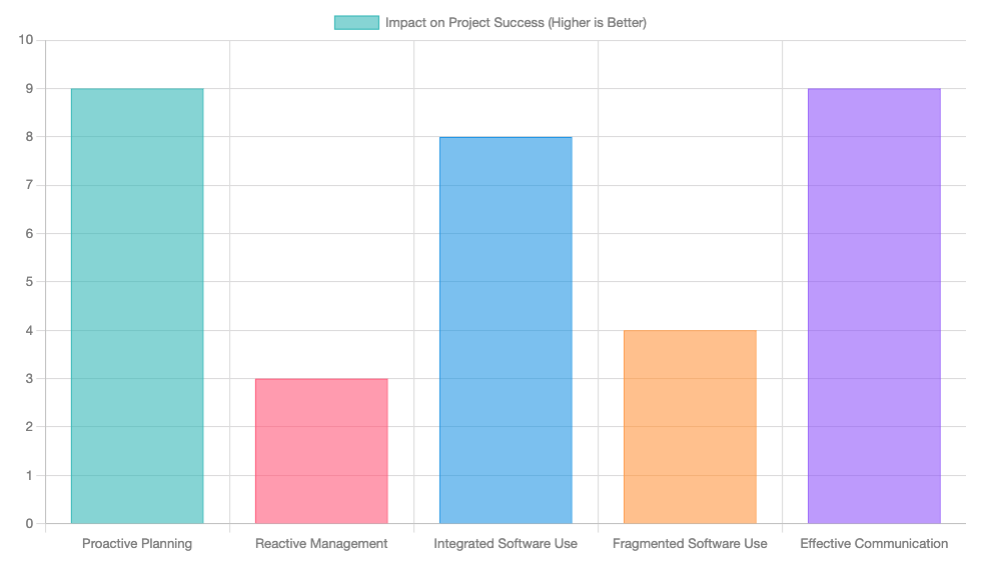Key Insights into Project Schedule Risk
- Weather delays impact nearly half of all construction projects globally, costing billions.
- Supply chain disruptions, like extended lead times for critical materials, create a domino effect across project phases.
- Regulatory changes introduce new compliance hurdles and can necessitate costly last-minute design or process adjustments.
- A proactive, integrated approach using technology like Archdesk is crucial for building effective buffers and mitigating these risks.
You know that feeling. The project schedule's all set, your crew's geared up, and then, out of nowhere, the forecast calls for a solid two weeks of rain. Or maybe that critical steel shipment, promised for Monday, is now stuck on a container ship halfway across the globe. Or perhaps a new regulation you didn't even see coming suddenly demands a last-minute design change. Sound familiar? For anyone running a construction company, it often feels like you're managing chaos as much as you're managing projects.
These aren't just little bumps in the road; they're serious project schedule risks that can throw timelines completely off track, blow through budgets, and turn what should have been a profitable job into a real financial headache. The truth is, you can't control the weather, global logistics, or every single legislative change. But you absolutely can control how you prepare for them. Let's really dig into the big three disruptors and talk about how to build a buffer that actually keeps your projects moving forward.

Construction site facing potential delays due to unforeseen circumstances.
Weather: Mother Nature's Wild Card
It’s the classic excuse, isn’t it? And for good reason. Data shows a staggering 45% of construction projects worldwide get hit by weather-related delays. Think about it: a single day of lost productivity on a big project can easily cost an owner a quarter of a million dollars. It's not just rain, either. Extreme heat can ruin a concrete pour, high winds can bring crane operations to a standstill, and deep freezes make almost any outdoor work a safety nightmare.
The old way of doing things was just to guesstimate a few "weather days" in the schedule. But honestly, a smarter approach involves hyper-local forecasting. Generic weather apps just won't cut it. You need tools that give you real-time, site-specific data. This lets you make really informed calls—maybe you pour concrete early, or you secure the site before a storm hits. It’s about moving from simply reacting to predicting what's coming.
It’s not just delays; safety plays a huge role too. Hot temperatures can exhaust workers, and icy conditions make sites incredibly dangerous. Even material quality can suffer. Concrete poured in bad weather might not reach its full strength, and wood exposed to moisture can warp. Imagine the headaches that can cause down the line!
You can't control the weather, that's for sure. But you can definitely plan for it. Many experienced project managers factor in "weather days" when they're drawing up timelines and budgets. It's about being realistic. Tools that integrate forecasts directly with your schedules, like those you can find within a robust system like Archdesk, help you adapt quickly. It’s about minimizing risk and ensuring compliance, even when the skies decide to open up.
Supply Chain Snarls: When Materials Disappear
If the pandemic taught us anything, it’s that our supply chains are pretty fragile. And four years on, those issues are still very much with us. Lead times for essentials like electrical switchgear can now stretch to 60 weeks, or even longer. The problem isn’t just delays; it’s the massive domino effect. A late shipment of structural steel doesn’t just delay the steelwork; it pushes back masonry, MEP rough-ins, and honestly, every other trade that follows.
Mitigating this mess requires a shift from just being a passive order-placer to becoming an active supply chain manager. This means ordering those long-lead items during the preconstruction phase, not waiting until you've already broken ground. It means building stronger relationships with your suppliers so you're a preferred customer when shortages hit. And let's be honest, it means having a Plan B. Identify alternative materials or suppliers before you desperately need them. This kind of visibility is pretty tough with just spreadsheets and phone calls. You really need a unified system that tracks orders and forecasts deliveries against your actual project timeline.
Supply chain issues don't just delay things; they can also inflate costs significantly, whether it's through storage fees or having to rush in expensive alternatives. And who bears that burden can lead to some nasty disputes. So, what do you do? Planning ahead is absolutely crucial. Diversifying suppliers, using alternative materials when it makes sense, and yes, having robust inventory management, are all smart moves. A platform like Archdesk can help you track materials, anticipate shortages, and keep communication flowing smoothly with suppliers, helping you avoid those painful surprises. It’s about having crystal-clear visibility into every step, so you’re never caught off guard.
Regulatory Roadblocks: Shifting Rules of the Game
Just when you think you've finally got a handle on the current building codes, the ground shifts again. New environmental rules, updated safety protocols like Ontario’s recent hygiene requirements for sites, or even sweeping legislation like the Inflation Reduction Act’s prevailing wage mandates can introduce costly compliance hurdles. And honestly, ignorance isn’t an excuse; the responsibility falls squarely on your shoulders to stay current.
Staying compliant means proactively monitoring these changes. It’s tedious manual work for a project manager, but it's absolutely essential. The goal is to integrate compliance checks directly into your project workflows. Instead of treating regulations as an afterthought, the right tools can flag potential issues early in the design and planning stages, saving you from expensive rework or even hefty fines down the line.
These aren't just minor tweaks. They can involve new environmental regulations, updated safety standards, or changes in labor laws, like prevailing wage requirements. For example, Bill 17 in Ontario proposes amendments to multiple acts, including the Planning Act and the Building Code Act. That's a significant shift! Staying compliant is non-negotiable; fines and project delays are the last thing anyone wants, right?
Navigating this maze requires a deep understanding of the rules and a reliable system to manage them. Staying updated on new legislation and its implications is vital. This is where investing in compliance software really comes in handy. Systems like Archdesk are built to help you track regulatory changes and maintain clear audit trails, making sure your projects meet all the necessary standards. It makes compliance a whole lot less daunting.
Crafting Your Buffer: Beyond Just Adding Time
So, how do you really build a buffer against these three giants? It’s not about just adding extra fat to the schedule; it’s about building a smarter, more resilient plan. First, integrate risk assessment directly into your scheduling. Use historical weather data for your specific location to make truly realistic plans. Identify your most critical supply chain dependencies and track them almost obsessively.
Second, embrace technology that gives you one single source of truth. Platforms like Archdesk bring your schedule, procurement, and compliance tracking all onto one dashboard. Unlike some more fragmented systems you might see from Procore or Autodesk, this integrated approach means a weather delay automatically adjusts your resource allocation, and a regulatory update is instantly communicated to the entire team. You actually see the impact of a delay in real-time, not weeks later in some report.
Finally, foster communication. When everyone—from the project manager to the site supervisor and even the supplier—is working from the same live data, problems get identified faster, and solutions are found collaboratively. Building a buffer isn’t about avoiding risks; that’s just impossible. It’s about creating an operation that can absorb the shock without falling over. By anticipating these disruptions and leveraging technology designed for construction’s unique chaos, you stop fighting fires and start moving forward, no matter what the world throws at your site.

This radar chart illustrates a comparative risk profile, showing how a project might look currently versus a scenario where an integrated platform like Archdesk is actively used for mitigation. The "Current Project Risk Profile" dataset (in red) highlights higher levels of vulnerability across weather, supply chain, and regulatory challenges, along with lower technology adoption and communication effectiveness. In contrast, the "Mitigated Risk Profile with Archdesk" (in blue) demonstrates a significant reduction in these external risks, achieved through enhanced technology adoption and improved communication, leading to a much more resilient project environment. This visual helps to quickly grasp the potential benefits of comprehensive risk management through a dedicated tech solution.
Building Buffers: A Strategic Approach
A buffer isn't just guesswork. It's time set aside specifically where variability is highest. We're talking about a few different kinds of buffers here:
- Project buffer on the overall end date. You can size this with simple ranges or, if you're really serious, a full schedule risk analysis. Even a light approach beats just hoping for the best.
- Feeding buffers where non-critical tasks feed into the critical path. This helps protect that main path from upstream wobbles and delays.
- Weather days by month, using local historical data. Load these directly into your baseline schedule so you don't have to argue about what's "normal" later.
- Material buffers for those truly long-lead items. Tie promised ship dates to your installation windows and give yourself a cushion that accounts for transit time and commissioning.
- Decision buffers for submittals and inspections. Regulatory time is real time, and it needs to be accounted for.
Contractual Considerations and Claims
Honestly, it pays to spell things out in your contracts. This includes force majeure clauses for things like supply chain failures, clear weather thresholds by month, notice periods, and what truly counts as an excusable delay. If compensation is limited, at least protect your time. Always keep meticulous records: daily logs, photos, weather forecasts, delivery promises, inspection dates. If weather or lead times exceed your baseline assumptions, your claim will stand a lot taller with solid documentation.

This mindmap visualizes the interconnected elements of project schedule risk in construction. It branches out from the central theme of "Project Schedule Risk Management" into the three primary categories: Weather, Supply Chain, and Regulatory Risks. Each category further details the nature of the risk, its impacts, and key mitigation strategies. A final branch, "Building a Buffer," ties these elements together by highlighting smarter planning, technology leverage, and communication as overarching solutions, with Archdesk positioned as a central tool for integrating these efforts. This provides a clear, hierarchical overview of the complex landscape construction leaders navigate.
How Archdesk Helps without the Fluff
Archdesk really puts your schedule, procurement, and compliance all in one place, so your buffers are based on actual evidence, not just optimism. Here's how it makes a real difference:

Yes, there are other big platforms out there—think Procore, Autodesk Construction Cloud, Aconex, Fieldwire, Viewpoint, Buildertrend. They're solid, no doubt. But what we often hear from CEOs is that they want less tool sprawl and more direct cause and effect. Archdesk really focuses on that linkage: material to task, rule to milestone, weather to float. Fewer clicks, clearer decisions, if you ask me. It is a lot wider solution that the mentioned above.

This bar chart illustrates the perceived impact of various management approaches and tool usages on overall project success, rated on a scale of 0 to 10. It contrasts positive strategies like "Proactive Planning," "Integrated Software Use," and "Effective Communication" with less effective ones such as "Reactive Management" and "Fragmented Software Use." The chart clearly shows that proactive and integrated approaches, bolstered by strong communication, lead to significantly higher success rates. This provides a visual confirmation of the narrative's emphasis on strategic planning and unified technology solutions for better project outcomes.
A Quick, Honest Wrap-Up
You can't stop the rain, or the global supply chain, or regulators from doing their thing. But you can certainly stop being surprised by them. Build those buffers right where the variability lives. Order early. Document that weather meticulously. Treat regulations like key schedule activities. And pull it all together in one system, like Archdesk. You know what? That’s often all it takes to buy back weeks, even months, on a project.
Frequently Asked Questions
What are the primary external risks to construction project schedules?
The main external risks are adverse weather conditions, unpredictable supply chain disruptions leading to material delays, and constant changes in regulatory requirements and building codes. These factors often combine to create significant challenges for project timelines and budgets.
How much do weather delays actually impact construction projects?
Adverse weather conditions impact approximately 45% of construction projects globally. This can lead to substantial financial losses, often amounting to hundreds of thousands of dollars per day on larger projects, and significantly extends project durations.
What strategies can help mitigate supply chain risks?
Effective mitigation strategies include ordering long-lead items during the preconstruction phase, building strong relationships with suppliers, diversifying suppliers, and identifying alternative materials. Utilizing an integrated system to track orders and forecast deliveries against the project timeline is also crucial.
How can construction companies keep up with regulatory changes?
Staying current with regulations requires proactive monitoring of new legislation and integrating compliance checks directly into project workflows. Employing compliance software that flags potential issues early in the design and planning stages can help avoid costly rework or fines.
What is a "buffer" in project scheduling, and how is it built effectively?
A buffer refers to strategic time allowances built into a project schedule to absorb unforeseen delays without impacting the final deadline. This includes project buffers (for the overall timeline), feeding buffers (to protect critical paths), weather day allocations based on historical data, material buffers for long-lead items, and decision buffers for approvals and inspections. It's about smart planning, not just adding arbitrary time.
References
Regulatory Roundup - Associated Builders and Contractors
Schedule risk analysis simplified | PMI
[PPT] Snippet 3-9: Schedule Risk Assessment (SRA) - Department of Energy
Project schedule, quality and risks – a brief guide





